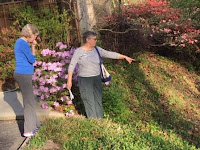On April 26, several Three Oaks owners and a FOSC representative walked several storm water project sites with the BayLand engineer. The engineer pointed out ways we can transform a concrete swale into conservation landscaping. Our goal is to have storm water seep into the ground instead of running down the swale and into the parking lot. One of our sites currently has a swale that empties into our parking lot, and the other site has a swale that flows down a steep hill, empties onto a cul-de-sac and flows into a storm drain leading to Sligo creek.
Both sites have challenges. The downhill swale is extremely steep, and we would like to slow the flow of rain water during heavy rain fall so that it seeps into the ground rather than flows into the storm drain. The best management practice will likely require us to build concrete or timbered berm that can hold a significant amount of water.
The second area is flat, but it has only a small area of open space and a great proximity of mature trees. Large trees would be at risk if we dug deeply around their root systems. Standard practice is not to dig deeply within a tree's "drip line" (the furthest out that the tree's branches reach). Storm water remediation underneath trees is more costly than projects in open areas. The engineer suggested using "filtration cells" to help maximize the space use. These cells temporarily collect and pond one foot of rain runoff, and they have two feet of sand and stone underneath to promote infiltration. Excess water is absorbed by native plants. Overflow goes into the storm system. Implementing this type of solution means the majority of the storm water is absorbed into a planted area instead of running into the parking lot.
Site photos
The second area is flat, but it has only a small area of open space and a great proximity of mature trees. Large trees would be at risk if we dug deeply around their root systems. Standard practice is not to dig deeply within a tree's "drip line" (the furthest out that the tree's branches reach). Storm water remediation underneath trees is more costly than projects in open areas. The engineer suggested using "filtration cells" to help maximize the space use. These cells temporarily collect and pond one foot of rain runoff, and they have two feet of sand and stone underneath to promote infiltration. Excess water is absorbed by native plants. Overflow goes into the storm system. Implementing this type of solution means the majority of the storm water is absorbed into a planted area instead of running into the parking lot.
Site photos
 |
| Assessing the trees: lots of drip line here |
 |
| Thinking about ways to redirect runoff so it doesn't go into the parking lot |
 |
| Standing at the top of the steep swale to the cul-de-sac |


